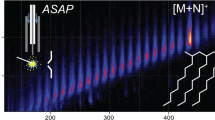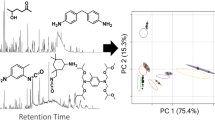Abstract
The class of fatty alcohol alkoxylates describes surfactants that are synthesised by reaction of fatty alcohols with alkoxides such as ethylene oxide or propylene oxide or a combination of both as copolymers. Such alkoxylates are used, for example, as nonionic surfactants in home and industrial cleaning and washing agents. Chemical characteristics of such alkoxylate copolymers, for example the degree of alkoxylation, the arrangement of building blocks (random or block polymerisation), the type of the starter, and endcapping, play an important role in application behaviour. The analysis of these characteristics is challenging because in many cases such copolymers have high polydispersity and a large number of constitutional isomers depending on the degree of alkoxylation. Furthermore, the alkoxylates often occur in a complex multicomponent matrix. Here we present a method for characterization of silylated fatty alcohol alkoxylates in the low-molecular-weight range by means of comprehensive two-dimensional gas chromatography–mass spectrometry with electron impact and chemical ionisation. This method also enables detailed analysis of the alkoxylates in a complex matrix such as modern detergents.













Similar content being viewed by others
References
McKenzie DA (1978) Nonionic surfactants. J Am Oil Chem Society 55:93–97
Thiele B, Nollet LML (eds) (2007) Analysis of surfactants in samples from the aquatic environment. In: Nollet LML, Handbook of water analysis. 2nd edn. CRC Press, pp 669–671
Santacesaria E, Di Serio M, Tesser R (2008) Production of Ethylene Oxyde/Propylenoxyde Oxyde Block Copolymers. In: Zoller U, Sosis P (eds) Handbook of Detergents: Part F: Production. CRC Press, New York, pp 253–256
Kosswig K, Stache H (eds) (1993) Die Tenside. Carl Hanser Verlag München, Wien
Karsa DR, Porter MR (eds) (1994) Biodegradability of surfactants. Springer Netherlands
Parker RE, Isaacs NS (1959) Mechanisms of epoxide reactions. Chem Rev 59:737–799
Fabry B (1991) Tenside-Eigenschaften, Rohstoffe, Produktion, Anwendungen. Chem Unserer Zeit 25:214–222
de Guertechin LO (ed)(1999) Surfactants: classification. In Handbook of detergents. Part A: Properties. Marcel Dekker, New York, pp 31–37
Andree H (ed) (1976) Waschmittelchemie-Aktuelle Themen aus Forschung und Entwicklung. A. Hüthig Verlag, Heidelberg
Combs MT, Johnson DD, Szekely-Klepser G (2005) Use of a liquid chromatography-ion trap mass spectrometer for end-group characterization of various polyethoxylate materials. J Surfactants Deterg 8:263–269
Jandera P, Fischer J, Lahovska H, Novotna K, Cesla P, Kolarova L (2006) Two-dimensional liquid chromatography normal-phase and reversed-phase separation of (co)oligomers. J Chromatogr A 1119:3–10
Janssen HG, de Koning S, Brinkman UA (2004) On-line LC-GC and comprehensive two-dimensional LC×GC–ToF MS for the analysis of complex samples. Anal Bioanal Chem 378:1944–1947
Schoenmakers PJ, Truyols G, Decrop WMC (2006) A protocol for designing comprehensive two-dimensional liquid chromatography separation systems. J Chromatogr A 1120:282–290
Janssen HG, Boers W, Steenbergen H, Horsten R, Floter E (2003) Comprehensive two-dimensional liquid chromatography×gas chromatography: evaluation of the applicability for the analysis of edible oils and fats. J Chromatogr A 1000:385–400
Dorman FL, Overton EB, Whiting JJ, Cochran JW, Gardea-Torresdey J (2008) Gas chromatography. Anal Chem 80:4487–4497
Mondello L, Tranchida PQ, Dugo P, Dugo G (2008) Comprehensive two-dimensional gas chromatography-mass spectrometry: a review. Mass Spectrom Rev 27:101–124
Bertsch W (1999) Two-dimensional gas chromatography. concepts, instrumentation, and applications-Part 1: Fundamentals, conventional two-dimensional gas chromatography, selected applications. J High Res Chromatogr 22:647–665
Schomburg G (1995) Two-dimensional gas chromatography: principles, instrumentation, methods. J Chromatogr A 703:309–325
Liu Z, Phillips JB (1991) Comprehensive 2-dimensional gas-chromatography using an on-column thermal modulator interface. J Chromatogr Sci 29:227–231
Dallüge J (2003) Multidimensionality in capillary gas chromatography. Master thesis, University of Amsterdam
Hubner J, Taheri R, Melchior D, Kling HW, Gab S, Schmitz OJ (2007) Analysis of tensides in complex samples with comprehensive two-dimensional gas chromatography coupled with time-of-flight mass spectrometry. Anal Bioanal Chem 388:1755–1762
Wulf V, Wienand N, Wirtz M, Kling HW, Gäb S, Schmitz OJ (2009) Analysis of special surfactants by comprehensive two-dimensional gas chromatography coupled to time-of-flight mass spectrometry. (accepted to J Chromatogr A)
Schilling FC, Tonelli AE (1986) C-13 NMR determination of poly(Propylene Oxide) microstructure. Macromolecules 19:1337–1343
Hesse M, Meier H, Zeeh B (eds) (1995) Spektroskopische Methoden in der organischen Chemie. 5th edn. Thieme Verlag Stuttgart
Wulf V (2007) Analyse von Tensiden in technischen Reinigerformulierungen mittels GC×GC–(TOF)MS. Diploma thesis, University of Wuppertal
Kaiser H, Specker H (1956) Bewertung und Vergleich von Analyseverfahren. Fresenius Z Anal Chem 149:46–56
Henze N (ed) (2008) Stochastik für Einsteiger. Springer Verlag, pp 189–194
Johnson AE, Geissler PR, Talley AD (1990) Determination of relative ethoxylation rate constants from supercritical fluid chromatographic analysis of ethoxylated alcohols. J Am Oil Chem Society 67:123–131
Geissler PR, Johnson AR (1990) Effect of process variables, degree of ethoxylation and alcohol structure on relative ethoxylation rate constants. J Am Oil Chem Society 67:541–546
Booth C, Attwood D (2000) Effects of block architecture and composition on the association properties of poly(oxyalkylene) copolymers in aqueous solution. Macromol Rapid Commun 21:501–527
Lu XJ, Myers MR, Artz WE (1993) Supercritical fluid chromatographic analysis of the propoxylated glycerol esters of oleic acid. J Am Oil Chem Society 70:355–360
Hodges KL, Kester WE, Weiderrich DL, Grover JA (1979) Determination of substitution in cellulose ethers by zeisel-gas chromatography. Anal Chem 51:2172–2176
Gronski W (1991) 13C-NMR characterization of ethylene oxide/propylene oxide adducts. Makromol Chem 19:591–601
Wittenbrink RJ, Mart CJ, Ryan DF, Cook BR (2002) High performance environmentally friendly, low temperature, drilling fluids. U.S. Patent 6,455,474,B1
Author information
Authors and Affiliations
Corresponding author
Rights and permissions
About this article
Cite this article
Dück, R., Wulf, V., Geißler, M. et al. Combination of chemical and electron-impact ionisation with GC×GC–qMS for characterization of fatty alcohol alkoxylate polymers in the low-molecular-weight range up to 700 Da. Anal Bioanal Chem 396, 2273–2283 (2010). https://doi.org/10.1007/s00216-009-3434-0
Received:
Revised:
Accepted:
Published:
Issue Date:
DOI: https://doi.org/10.1007/s00216-009-3434-0




